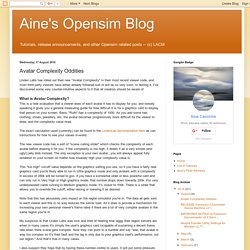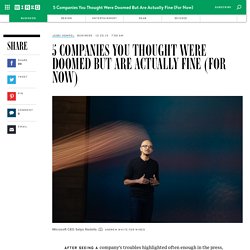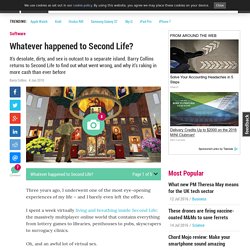

Aine's Opensim Blog: Avatar Complexity Oddities. Linden Labs has rolled out their new "Avatar Complexity" in their most recent viewer code, and most third party viewers have either already followed suit or will do so very soon.

In testing it, I've discovered some very counter-intuitive aspects to it that all creators should be aware of. What is Avatar Complexity? This is a new evaluation that a viewer does of each avatar it has to display for you, and loosely speaking it gives you a general measuring guide for how difficult it is for a graphics card to display that person on your screen. Basic "Ruth" has a complexity of 1000. As you add some hair, clothing, shoes, jewellery, etc, the avatar becomes progressively more difficult for the viewer to draw, and the complexity value rises. The exact calculation used (currently) can be found in the LindenLab documentation here as can instructions for how to see your values in-world. Note that this has absolutely zero impact on the region simulator you're in. That's the theory. Some Details. Pokémon GO et la quatrième dimension de la propriété – – S.I.Lex – Ces dernières semaines auront été marquées par la folie Pokémon Go et une annonce a priori assez délirante me donne l’occasion d’aborder ce sujet sous l’angle juridique.
On a appris en effet que le maire de la commune de Bressolles, petit village de 800 habitants dans l’Allier, avait pris un arrêté pour « interdire l’implantation de Pokémon sur la commune », en avançant des motifs de sécurité. IP and Business: Second Life - Brand Promotion and Unauthorized Trademark Use in Virtual Worlds. November 2007 The strong identification of users with their online avatars has captured the attention of big brand owners.

(Image: Second Life) Intellectual property (IP) is the basis for the creation and protection of rights in online gaming. But the creators of virtual worlds, such as Second Life, also recognize the new IP developed by the players who interact and evolve in the worlds they have created. This has become the basis for buying and selling creations in such worlds, and has made millionaires in the real world. An entirely new world is emerging as a hotbed for brand promotion as well as possible trademark infringement – the world of virtual reality.
“You retain copyright and other IP rights with respect to content you create in Second Life.” – Second Life, Terms of Service, 3.2 Opportunities and challenges Linden Lab responds to allegations of copyright infringement in accordance with the process and procedures of the U.S. Forgotten Wonders of the Digital World: Second Life. Has anyone seen all my chairs?

(Photo: Ziki Questi) What does a three-dimensional version of the Internet look like? Absurde, créatif et débauché : dix ans après, « Second Life » est toujours bien vivant. A quoi ressemble aujourd’hui ce célèbre jeu ?

Contrairement à ce que l’on pourrait croire, il fourmille toujours de vie et de surprises. Immersion. LE MONDE | • Mis à jour le | Par Morgane Tual Le sable blanc, le bruit des vagues et une vieille carcasse de bateau. Une femme est assise sur un muret, vêtue d’un jean et d’un soutien-gorge noirs, silencieuse. Why Is 'Second Life' Still a Thing? To an outsider, Second Life may look like a crappier version of World of Warcraft.

It’s a vast digital space many people can log into with their virtual avatars, only instead of going on wild adventures, slaying dragons and collecting epic swords, it just seems like a bunch of people hanging out in bars, offices, galleries—normal places. That’s a fair assessment of Second Life, but what makes it special and lasting isn’t as apparent. Yes, Second Life, which first launched in 2003, looks incredibly dated. Thirteen years is an eon in the technology business. There are massively multiplayer games that look prettier, bigger social networks that are better integrated to our daily routines, and video games that are far more fun to play. The short answer is that there’s nothing else quite like it. A crucial difference between Second Life and MMOs like World of Warcraft is that the latter are mostly fixed worlds.
If you let users make whatever they want, they’ll make a lot of sex stuff. 5 Companies You Thought Were Doomed But Are Actually Fine (For Now) After seeing a company’s troubles highlighted often enough in the press, it’s easy to start seeing doom just around the next quarterly bend.

But many companies with troubles of all sorts have the patience and capital to persist for a long time. Here are five companies that are in better shape than you may think—at least for now: Dropbox: Dropbox had a speedy public ascent when it launched in 2007, fueled by mass user adoption and plenty of press hype. Five years later, the company is in a rough position. It is reportedly valued at $10 billion. Laurent Gout, l'urgentiste Géo Trouvetou du CHU - 20/12/2015 - ladepeche.fr. Ce qui frappe au prime abord, chez Laurent Gout, c'est son flegme.

Nos cousins britanniques, qui se targuent d'être les détenteurs de cette qualité et qui revendiquent le titre de champions du monde du stoïcisme devant l'adversité, peuvent aller se rhabiller. Car en la matière, leur maître est bien Toulousain. Sous cette carapace d'impassibilité se cache pourtant l'un des plus grands hyperactifs de la Ville rose. Whatever happened to Second Life? Three years ago, I underwent one of the most eye-opening experiences of my life – and I barely even left the office.

I spent a week virtually living and breathing inside Second Life: the massively multiplayer online world that contains everything from lottery games to libraries, penthouses to pubs, skyscrapers to surrogacy clinics. Oh, and an awful lot of virtual sex. Back then, the world and his dog were falling over themselves to “bea part of it”. Rock stars were queuing up to play virtual gigs, Microsoft and IBM were setting up elaborate pixellated offices to host staff training seminars, Reuters even despatched a correspondent to report back on the latest in-world developments. At its peak, the Second Life economy had more money swilling about than several third-world countries. Three years on, and the hype has been extinguished.